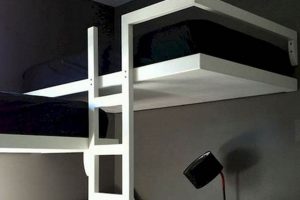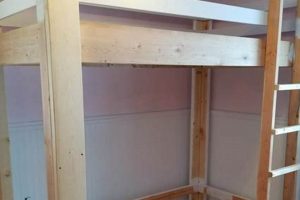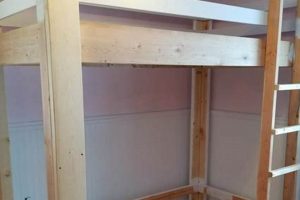The process involves applying a protective coating to the cargo area of a pickup truck, typically undertaken by the vehicle owner. This endeavor aims to shield the truck bed from damage caused by impacts, abrasion, and corrosion. For example, a truck owner might apply a spray-on compound to prevent scratches when hauling construction materials.
Protecting the truck bed enhances the vehicle’s resale value and extends its lifespan by preventing rust and physical degradation. Historically, such protection was limited to drop-in plastic liners, but advancements in chemical coatings have provided more durable and customizable alternatives. This method offers cost savings compared to professional application and allows for tailored protection based on individual needs.
Subsequent sections will detail the various types of materials available, the preparation steps necessary for optimal adhesion, the application techniques involved, and safety precautions to consider during the coating process. Understanding these facets is crucial for achieving a professional-grade result.
Enhancing Durability
Achieving a durable and long-lasting finish necessitates meticulous planning and execution. Adherence to best practices is vital for optimal results.
Tip 1: Surface Preparation is Paramount: Thoroughly clean and degrease the truck bed surface. Remove all rust, loose paint, and debris through sanding or grinding. A clean, abraded surface promotes optimal adhesion.
Tip 2: Material Selection Matters: Choose a coating specifically formulated for truck bed applications. Consider the desired texture, durability, and resistance to UV exposure. Research product reviews and specifications carefully.
Tip 3: Adhere to Manufacturer’s Instructions: Strictly follow the manufacturers recommended mixing ratios, application thicknesses, and curing times. Deviations can compromise the coatings integrity.
Tip 4: Apply in Multiple Thin Coats: Avoid applying a single thick layer. Multiple thin coats, allowed to dry between applications, ensure even coverage and prevent runs or sags.
Tip 5: Utilize Proper Application Techniques: For spray-on coatings, maintain a consistent distance and angle with the spray gun. For roll-on applications, use a high-quality roller designed for textured coatings. Ensure uniform coverage.
Tip 6: Temperature and Humidity Considerations: Apply the coating within the temperature and humidity ranges specified by the manufacturer. Extreme conditions can affect the curing process and the final finish.
Tip 7: Allow Adequate Curing Time: Resist the urge to use the truck bed before the coating is fully cured. Premature use can damage the uncured coating and compromise its protective properties.
Implementing these measures will contribute to a protective layer that withstands harsh conditions, extending the lifespan of the truck bed and maintaining its aesthetic appeal.
The subsequent article sections will address common pitfalls and explore advanced techniques for customized applications.
1. Material Selection
The choice of coating material constitutes a critical decision point in the process. The selected material directly influences the final product’s durability, resistance to environmental factors, and overall suitability for the intended application.
- Polyurethane Coatings
Polyurethane formulations offer a balance of abrasion resistance and flexibility. They are generally more affordable compared to other options, making them suitable for general-purpose use. However, polyurethane coatings may exhibit lower UV resistance, potentially leading to fading or discoloration over time. For instance, a truck primarily used for hauling landscaping materials might benefit from a polyurethane coating due to its abrasion resistance against rocks and mulch.
- Polyurea Coatings
Polyurea coatings are characterized by their exceptional durability and fast curing times. They exhibit superior resistance to chemicals, impacts, and UV degradation compared to polyurethane options. Polyurea coatings are typically more expensive, making them suitable for heavy-duty applications requiring maximum protection. Example: Vehicles regularly transporting heavy machinery or exposed to harsh chemicals would benefit from a polyurea coating. Their fast curing time allows for a quicker return to service.
- Epoxy Coatings
Epoxy coatings provide excellent adhesion and chemical resistance. They are often used as a primer layer to enhance the bonding of subsequent topcoats. However, epoxy coatings are generally less flexible than polyurethane or polyurea, making them susceptible to cracking under severe impact. The increased hardness of the truck bed could reduce the impact it can withstand for a similar impact to polyurethane or polyurea coating.
- Hybrid Coatings
Hybrid coatings combine the properties of two or more materials to achieve a specific performance profile. For example, a polyurethane-polyurea hybrid coating might offer a compromise between cost, durability, and UV resistance. These formulations are often tailored to specific application requirements, offering a wider range of customization options. Using a hybrid coating with a lower density could greatly lower the cost of the materials.
Ultimately, selecting the appropriate coating material necessitates a careful assessment of the truck’s intended use, the anticipated environmental conditions, and the budget constraints. The chosen material directly determines the success and longevity of the protective coating applied to the truck bed, influencing its resistance to damage and degradation over time.
2. Surface Preparation
Surface preparation is a critical determinant of success in any do-it-yourself truck bed liner application. The quality and longevity of the applied coating are directly proportional to the thoroughness of the preparation process. Inadequate preparation invariably leads to premature coating failure, manifesting as peeling, cracking, or delamination. This relationship underscores the necessity of diligent adherence to best practices in surface preparation. For example, if a truck bed is not properly sanded to create a mechanical bond, the liner will not adhere correctly, especially under the stress of hauling heavy loads. This leads to early wear and potential compromise of the truck bed’s integrity.
The process encompasses several key steps: cleaning, degreasing, sanding, and rust removal. Cleaning removes loose debris and contaminants. Degreasing eliminates oils and waxes that inhibit adhesion. Sanding provides a rough surface for mechanical bonding of the liner. Rust removal prevents corrosion from undermining the coating. Each step contributes to a stable and receptive substrate. Consider a truck bed that has been exposed to road salt; simply applying a liner without removing the rust will trap the corrosive elements, accelerating degradation beneath the coating. Proper rust removal, followed by a suitable primer, prevents this outcome.
In summary, meticulous surface preparation represents a non-negotiable prerequisite for a durable and effective DIY truck bed liner. Neglecting this stage compromises the entire project, resulting in wasted materials, time, and ultimately, inadequate protection for the truck bed. Understanding the causative link between preparation quality and liner performance is crucial for achieving a professional-grade result and ensuring the long-term preservation of the vehicle’s utility and value.
3. Application Technique
The effectiveness of a do-it-yourself truck bed liner project hinges significantly on the chosen and executed application technique. Different methods, such as spraying, rolling, or brushing, each offer distinct advantages and disadvantages that impact the final outcome. Improper application can lead to uneven coating, insufficient thickness, or compromised adhesion, thereby negating the protective benefits intended. A coating applied too thinly, for example, may fail to protect against impacts from heavy cargo, rendering the entire endeavor ineffective. Conversely, an uneven spray pattern can create weak spots vulnerable to corrosion or abrasion. Understanding the nuances of each application technique is therefore crucial for achieving a durable and aesthetically pleasing result. Without proper understanding or attention, the truck bed liner diy results in an incomplete work or has the potential to waste the entire project.
Spray-on applications, typically involving specialized equipment, provide a textured finish and uniform coverage, particularly in hard-to-reach areas. This technique necessitates careful control of spray pressure and nozzle distance to avoid runs or dry spots. Roll-on applications, using textured rollers, offer a more accessible option for DIYers and can achieve a similar textured appearance. However, maintaining consistent pressure and overlap is essential to prevent streaking or thin patches. Brush-on applications, while less common for large areas, may be suitable for detail work or touch-ups. Each method requires specific surface preparation and environmental conditions for optimal results. Failing to account for factors such as temperature and humidity can adversely affect the curing process and the long-term durability of the liner. The quality of these diy steps and the right equipments is required for truck bed liner diy to succeed
In conclusion, the choice of application technique represents a pivotal decision in a do-it-yourself truck bed liner endeavor. The selection should align with the applicator’s skill level, the available equipment, and the desired finish. Strict adherence to the manufacturer’s instructions, coupled with meticulous attention to detail during application, is paramount for maximizing the protective capabilities and extending the lifespan of the truck bed liner. Mastery in application steps of truck bed liner diy provides value and protection to the user.
4. Curing Process
The curing process constitutes a critical phase in the application of a truck bed liner. It dictates the final properties of the coating, including its hardness, durability, and resistance to environmental factors. Proper curing ensures the liner achieves its intended protective function, safeguarding the truck bed from damage and corrosion. The success of any truck bed liner diy project relies heavily on adhering to the specified curing parameters. In truck bed liner diy the curing process requires a great focus.
- Temperature Sensitivity
Curing is temperature-dependent. Many coatings require a specific temperature range to initiate and complete the cross-linking process effectively. Deviations from the recommended temperature can result in incomplete curing, leading to a soft, tacky finish or reduced durability. For instance, applying a liner in cold weather without proper heating can significantly extend the curing time and compromise the final hardness. A high level of temperature will allow quick drying.
- Humidity Influence
Humidity levels also affect the curing process, particularly for moisture-cured coatings. High humidity can accelerate curing, potentially leading to surface imperfections or blistering. Conversely, low humidity may slow down the curing rate, prolonging the time required before the truck bed can be used. The environment is significant in this process.
- Curing Time Variations
Different coating materials exhibit varying curing times, ranging from a few hours to several days. The specific curing time depends on the chemical composition of the liner and the prevailing environmental conditions. Premature use of the truck bed before complete curing can damage the coating and compromise its protective properties. The diy has to be patient to see the optimal result.
- Post-Curing Considerations
Some coatings benefit from a post-curing period, where the material continues to harden and strengthen over time. This process may involve maintaining specific temperature and humidity conditions to optimize the final properties of the liner. Ignoring post-curing recommendations can reduce the long-term durability and resistance of the coating. The maintenance after the work needs time as well.
The curing process is non-negotiable for achieving the desired outcome in truck bed liner diy. Strict adherence to manufacturer’s instructions regarding temperature, humidity, and curing time is essential for realizing the full protective potential of the coating. This proactive approach safeguards the investment and ensures the long-term preservation of the truck bed’s integrity. In diy works, patience is important to follow the instruction.
5. Safety Measures
The execution of truck bed liner DIY projects necessitates stringent adherence to safety protocols due to the inherent risks associated with chemical exposure, particulate inhalation, and potential physical hazards. The materials employed often contain volatile organic compounds (VOCs) and other substances that pose health risks upon inhalation or skin contact. Failure to implement appropriate safety measures can result in respiratory irritation, skin sensitization, or more severe long-term health consequences. For instance, the prolonged inhalation of isocyanates, commonly found in polyurethane coatings, can lead to asthma and other respiratory ailments. Therefore, safety is more important than all the aspects.
The application process itself introduces further hazards, including the risk of slips, trips, and falls, particularly when working within the confines of a truck bed. Proper ventilation is crucial to minimize exposure to airborne particles and chemical fumes. Personal protective equipment (PPE), such as respirators, gloves, and eye protection, serves as a critical barrier against these hazards. A respirator with appropriate cartridges effectively filters out harmful vapors and particulate matter, while gloves prevent skin contact with potentially irritating or corrosive substances. Neglecting these precautions can lead to immediate discomfort or chronic health problems. The proper attire and safety precautions are required in this DIY project.
In summary, integrating comprehensive safety measures into truck bed liner DIY projects is not merely a recommendation but a fundamental requirement. Prioritizing worker safety through adequate ventilation, appropriate PPE, and thorough understanding of material safety data sheets (MSDS) mitigates potential health risks and ensures a safe and successful outcome. Disregarding safety protocols compromises the well-being of the individual and potentially undermines the long-term benefits of the protective coating. The precautions protects the individual and others.
6. Long-Term Maintenance
The durability and protective capability of a DIY truck bed liner are intrinsically linked to diligent long-term maintenance practices. The initial application, regardless of its quality, represents only one phase in ensuring sustained performance. Neglecting routine maintenance exposes the coating to premature degradation, diminishing its ability to withstand abrasion, chemical exposure, and ultraviolet radiation. A direct causal relationship exists between consistent maintenance and the extended lifespan of the liner. For example, failure to promptly remove corrosive substances, such as road salt or spilled chemicals, allows for prolonged contact, potentially leading to delamination or weakening of the protective barrier. Regular maintenance is the key for the DIY to work.
Long-term maintenance encompasses several key actions. Periodic cleaning removes accumulated dirt, grime, and debris that can abrade the surface or harbor corrosive agents. Inspection for scratches, gouges, or other damage allows for timely repairs, preventing minor issues from escalating into more significant problems. Application of UV protectants, specifically designed for truck bed liners, mitigates the damaging effects of sunlight, preserving the coating’s color and flexibility. Furthermore, addressing minor damages immediately with appropriate repair kits ensures the integrity of the liner remains intact, preventing moisture intrusion and subsequent corrosion of the underlying metal. Proper maintenance prevents damages to the truck bed.
In essence, the long-term success of a truck bed liner DIY project hinges on the implementation of a proactive maintenance regimen. While the initial application provides a protective barrier, continuous care is essential for maximizing its lifespan and preserving its functionality. Neglecting maintenance diminishes the investment made in the DIY project, ultimately compromising the intended protection and potentially necessitating costly repairs or replacements. Thus, long-term maintenance should be seen as an integral and ongoing component of the entire truck bed liner DIY process. With the proper maintenance, the DIY project is a success.
Frequently Asked Questions
The following addresses common inquiries concerning the application and maintenance of truck bed liners, providing guidance for optimal results and longevity.
Question 1: What are the primary benefits of undertaking a truck bed liner DIY project?
Applying a protective coating offers several advantages, including safeguarding the truck bed against scratches, dents, and corrosion. It also potentially enhances the vehicle’s resale value by maintaining its aesthetic condition and structural integrity.
Question 2: What preparatory steps are crucial prior to applying a truck bed liner?
Thorough surface preparation is paramount. This involves cleaning the truck bed to remove dirt and debris, degreasing to eliminate oils, sanding to create a receptive surface, and addressing any existing rust to prevent further corrosion beneath the coating.
Question 3: What types of materials are commonly used in truck bed liner DIY applications?
Common materials include polyurethane, polyurea, epoxy, and hybrid coatings. Each offers distinct advantages regarding durability, chemical resistance, and ease of application. The selection should align with the intended use of the truck and the desired level of protection.
Question 4: How does the application technique influence the final outcome of a truck bed liner DIY project?
The chosen application method, whether spray-on, roll-on, or brush-on, significantly impacts the texture, uniformity, and adhesion of the coating. Proper technique, as specified by the manufacturer, is essential for achieving optimal results and preventing premature failure.
Question 5: What safety precautions should be observed during a truck bed liner DIY application?
Implementing strict safety measures is vital due to potential exposure to harmful chemicals and particulate matter. This includes ensuring adequate ventilation, wearing appropriate personal protective equipment such as respirators and gloves, and adhering to all safety guidelines provided by the coating manufacturer.
Question 6: What long-term maintenance practices are recommended for preserving a truck bed liner?
Regular cleaning removes debris that can abrade the coating. Periodic inspections allow for prompt identification and repair of minor damages. Application of UV protectants helps prevent fading and degradation caused by sunlight exposure, extending the liner’s lifespan.
Careful planning, meticulous execution, and ongoing maintenance contribute to the durability and effectiveness of the protective layer.
The subsequent article section will address common challenges and potential solutions.
Truck Bed Liner DIY
This exploration of the “truck bed liner diy” process has underscored the critical factors that determine its success. From meticulous surface preparation and informed material selection to precise application techniques and adherence to curing parameters, each step contributes significantly to the final outcome. The long-term durability and protective capabilities of the applied coating are directly contingent upon the diligence exercised throughout the entire process, including the implementation of appropriate safety measures.
Ultimately, the decision to undertake “truck bed liner diy” represents a commitment to protecting and enhancing the utility of a valuable asset. However, this commitment necessitates a thorough understanding of the inherent complexities and a willingness to invest the time and effort required for proper execution. Only through informed decision-making and rigorous application of best practices can the full potential of “truck bed liner diy” be realized, providing enduring protection and preserving the value of the vehicle.


![DIY Truck Bed Rack: Build Your Own Bed Rack [Plans] The DIY Hub: Creative Crafts, Repairs & Life Hacks DIY Truck Bed Rack: Build Your Own Bed Rack [Plans] | The DIY Hub: Creative Crafts, Repairs & Life Hacks](https://craftingdiycenter.com/wp-content/uploads/2025/07/th-2452-300x200.jpg)




